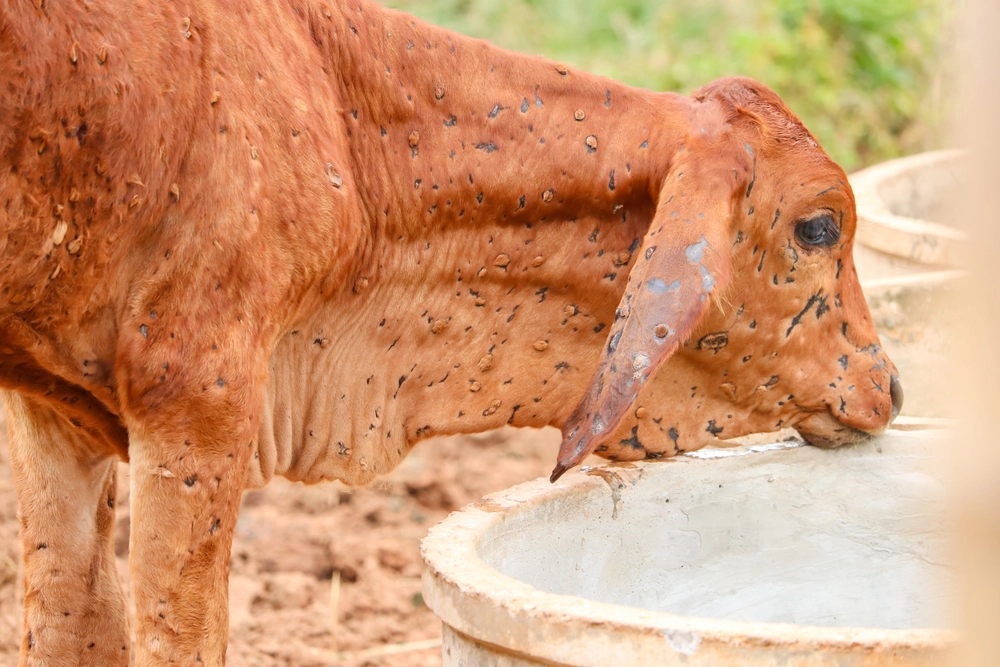Lumpy Skin Disease (LSD) threatens to annihilate the entire livestock near Eid-ul-Azha
A Gujrat based dairy farmer got all of his 40 cows vaccinated against the fast-spreading Lumpy Skin Disease (LSD) and he said that he would know the result after 28 days that whether the cows are out of danger or not. He decided not to wait for the government and bought the imported vaccine from market which cost him 17600 to vaccinate his 40 cows as 100ml is for 44,000 and 1ml is needed per head.
Total of 8 million families are engaged in the livestock industry. According to Pakistan Economic Survey, the largest sub-sector in agriculture contributed 60.1 per cent to the agriculture value addition and 11.5pc to the GDP during the 2020-21 financial year. Punjab manages up to 90pc of the country’s milk requirements,63,684 tonnes of milk produced in 2021 (including goat and camel), 30,691 tonnes was produced by buffaloes and 18,686 tonnes by cows. The small farmers are those with almost 50 livestock. Rasool, the chief organiser of DCFA in Punjab, believes the LSD spread from Sindh province and enveloped all 36 districts.
This disease was first discovered among livestock in Zambia during 1929, which is vector-borne transboundary disease found among cattle and water buffaloes and spreads primarily through biting of mosquitoes and ticks. According to Dr Tahir Yaqub, spokesperson of the University of Veterinary and Animal Sciences (UVAS) in Lahore, this is a 100pc non zoonotic disease and it causes the cattle to suffer from “high temperature, much discomfort and loss of milk production”. According to Dr Zaka Ullah Pathan, a veterinarian based in Khairpur, Sindh, if a female coe is infected then its reproductive organs a severely affected and the milk production drops from average 8 litres to 1.5litres.
According to the Ministry of National Food Security & Research, there are 42million buffaloes and 51million cows in Pakistan and this disease can prove as a death blow to many small dairy farmers. Gujjar reported that when the disease spread in Karachi the people stopped buying milk from milk shops and they had to sell the milk t bigger companies in very low rates and sold same milk in their own packing. “They started buying truckloads of our milk for as little as Rs 800 for 40 litres, although the pre-LSD rates were Rs 4,780 for 40 litres,” said Gujjar.
Dr Nazeer Hussain Kalhoro, director general of the Sindh Institute of Animal Health, run by the provincial government’s livestock department is of the view that animals often cross borders and disease may have come from India as this disease was reported in Iran and India before being reported from Bahawalpur, Punjab in November 2021, Pakistan. Dr Yaqub, on the other hand, believes the disease may have come from the imported livestock that landed at the port at Karachi last year. Gujjar stated about the negligence of authorities who refused to acknowledge the disease when it spread in the port city of Karachi. The government finally took action when we opted for press release. He also claimed, “The first vaccines to arrive in the country were kept at the cold storage at Karachi airport for a month before they were allowed to be used.” All meat and milk-sellers stood against Gujjar for bringing this disease into governments knowledge.
Read Also: Diseased Animals Enter Livestock Market
With Eidul Azha drawing closer, cows markets set up across the country will probably end up being super-spreader occasions, cautioned Gujjar. In Karachi, the provincial livestock department has deputed veterinarian specialists and staff at the principal market off the Super Highway to review dairy cattle being acquired and guarantee no domesticated animals tainted by the infection tracks down its direction to the slows down. “I would recommend everyone to only purchase animals for Eidul Azha two days prior to the festival,” said Gujjar. “This way, you would ensure that the animal is healthy at the time of slaughter because even though it may have been infected, the viral load would be negligible and won’t affect the animal’s health.”







